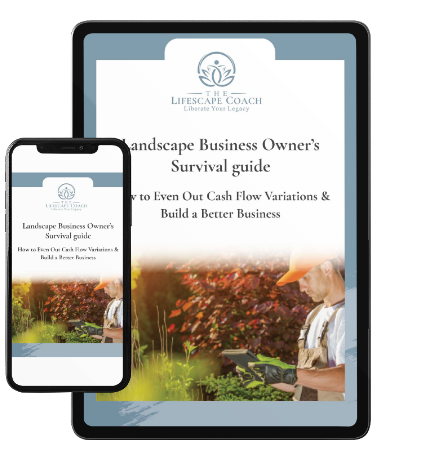The #1 Pitfall To Avoid with Your Business’s Cash Flow Variation
One of the biggest challenges for landscape contractors is managing cash flow. Seasonal variations, fickle customers, weather, and suppliers can all wreak havoc on your cash flow – one week you can be rolling in dough and the next struggling to meet payroll. What’s a landscape professional to do?
First and foremost, establish a reliable banking relationship and an appropriate line of credit. Then use it. The Number One pitfall that traps small business owners such as landscape contractors and designers is using their own money to address short-term cash flow variations.
I know, I know. That’s probably not the advice you really wanted to hear, but you need to hear it. Banks are not the enemy. In fact, a good bank will be the very friend you need when you’re experiencing a cash crunch and need a little help.
If you’re like a lot of landscape professionals that have taken the leap into self-employment, chances are you’ve always bootstrapped your business – loaning it your own money when needed, going without a paycheck when necessary. But that’s wrong. I know, because I have done it myself. This approach will hurt you in the end. You should be using the bank’s money before you use your own. Why? Because if you cash out your own assets first by, say, getting a line of credit on your house or worse a second mortgage, then you are using your personal collateral up for business expenses and possibly to cover mismanagment. If you do that first, then you wait until you really need the money to apply for a business loan, chances are good the bank won’t give you one.
A solid banking relationship and a good credit line is one of the best ways to get through the slow times and ensure you have cash available when you need it. How much credit? A good rule of thumb is; if you think you need a dollar, ask for two. The last thing you want to happen is to have to go to the well, only to find it dry.
Of course, having access to that kind of cash requires discipline and responsibility on your part. It’s critical to develop internal accountability so that when you’re flush with money – say, at the end of the season when all of your clients have paid up for the season -- you promptly pay back what you’ve borrowed and refill the well.
 As you build your business and establish a loyal client base (see our previous blog post on creating client loyalty), another form of credit comes into play – your clients. If you’ve taken our advice and began systematically requesting and receiving advance payments, this cash can help fund your next season’s start-up, freeing up your bank’s line of credit to fill in the cash flow gaps you’re inevitably going to experience throughout the season.
As you build your business and establish a loyal client base (see our previous blog post on creating client loyalty), another form of credit comes into play – your clients. If you’ve taken our advice and began systematically requesting and receiving advance payments, this cash can help fund your next season’s start-up, freeing up your bank’s line of credit to fill in the cash flow gaps you’re inevitably going to experience throughout the season.
A good line of credit smooths out your cash flow variations and enables you to begin thinking about investing in a larger workforce, more equipment, perhaps an expanded territory. Just don’t let all that available cash go to your head. Remember, it’s the bank’s money, not yours.
As you build a positive credit history by borrowing and repaying reasonable amounts, you can increase your line of credit and use it to increase your business. There’s an old business saying, “You have to spend money to make money.”
Landscape Business Owners Survival Guide



